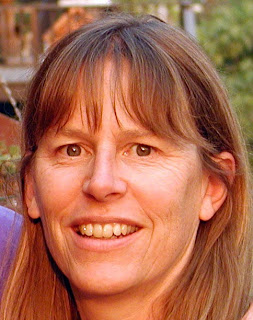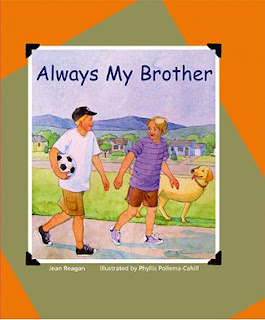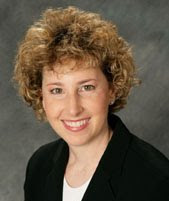new posts in all blogs
Viewing Blog: Jill's Writing and Play Therapy Page, Most Recent at Top
Results 26 - 50 of 112
About Jill Osborne' Writing Projects, and Interest in play therapy.
Statistics for Jill's Writing and Play Therapy Page
Number of Readers that added this blog to their MyJacketFlap: 2
I am excited to announce that I have joined Eagles Landing Christian Counseling Center and will be seeing clients at the McDonough and Conyers offices. I am currently taking Cigna and Private Pay Clients. I am pursuing other insurance panels, including Amerigroup and Centpatico. I am a play therapist and a writer, I wrote the book "Sam Feels Better Now," and I help children learn how to cope with traumatizing situations and disabilities. I can see ages 3 and older. I am hoping to find more time to write, blog and teach. If you are interested in referring to me please contact me.
Eagles Landing Office Phone: 770-898-2966 or my
Cell Phone: 404-234-0546.
Email address: [email protected]
Blog: www.jillosborne.org
Eagles landing website: http://www.eagleslandingchristiancounseling.com/
Thank you for reading!
By:
Jill Osborne,
on 8/27/2011
Blog:
Jill's Writing and Play Therapy Page
(
Login to Add to MyJacketFlap)
JacketFlap tags:
parenting,
parents,
hurricanes,
Play Therapy,
crisis intervention,
trauma,
Child Therapy,
children self help,
natural disasters,
children,
Add a tag
Wondering how to talk to your children about preparing and the effects of hurricanes? Sesame Street has developed a hurricane tool kit to assist parents and children in talking about and preparing for a natural disaster. There are 5 videos, each discussing different aspects of preparation and also tips on dealing with the aftermath, such as having a routine, finding support, and self care. I watched several of the video clips, each about 15 minutes long, and they show realistic emotions, preparations and after effects. You can check out www.sesamestreet.org, click on the parents section and click on the tool kits tab. There are other topics addressed as well. As a therapist, I appreciate the approach that the folks at Sesame Street took on dealing with a disaster that can cause lots of instability for children and their families.

I am thrilled to post this interview of author Jean Reagan, who is the author of "Always My Brother." "Always My Brother" is a story for children who are dealing with sibling death. This is the first book I have read on this specific form of grief, and I highly recommend it for use with clients, and for parents who may be dealing with their own child's death. Please visit Jean's website and read the Story Behind section if you would like more information about their journey of grief, and inspiration for this book.
1. What inspired you to make this a children’s book?
First, some background. In 2005 after a roller-coaster year of hopes and setbacks, our nineteen-year old son, John, died of a drug overdose Jane, our seventeen-year old daughter became an only child. As we faced our grief, I watched how the death of a sibling is discounted. Well-meaning people offered me (and my husband) comfort, but rarely seemed to acknowledge Jane's tragic loss.
Through research I learned that sibling death is often considered the unrecognized grief. Surviving siblings are sometimes even admonished to be “extra good,” because their parents are grieving. In ALWAYS MY BROTHER I wanted to honor siblings for the devastating loss they face, to normalize the contradictory emotions they experience, and to offer them realistic hope.
I chose to write a picture book rather than a teen book for several reasons. A. There are many teen books about loss of all kinds, including sibling death. B. There are no picture books aimed at a young audience on this topic. (In fact, a "Needed Subjects" column in a writers' magazine expressed a need for picture books about the death of a sibling.) C. As an author, picture books are what I write.
On a personal level, I wrote this book because I wanted my daughter to understand that at some level I understand the utter devastation n of her loss.
n of her loss.
Because ALWAYS MY BROTHER is aimed at a young audience, it does not exactly mirror our own family story.
 I recently attended a wonderful 2-day sandtray workshop with Denise Filley at Marietta Counseling Center for Children and Adults in Marietta, GA. I have been using sandtray work with my clients since I began this journey of becoming a play therapist, this was the most comprehensive training on sandtray work that I have attended. We covered a range of topics including materials, history of sandtray therapy, and also different perspectives of using the sandtray.
I recently attended a wonderful 2-day sandtray workshop with Denise Filley at Marietta Counseling Center for Children and Adults in Marietta, GA. I have been using sandtray work with my clients since I began this journey of becoming a play therapist, this was the most comprehensive training on sandtray work that I have attended. We covered a range of topics including materials, history of sandtray therapy, and also different perspectives of using the sandtray.
This workshop was highly experiential, including practicing with a partner, group activities, and also individual sandtrays.My favorite part of the training was a partner activity where we did mutual story telling in the sandtray. I had the privilege of practicing that activity with a co-worker, and we took turns picking a figure and adding a story line. I found that after this weekend workshop, we created about 6-7 different types of sandtrays, and I stayed with the same partner throughout the training. At the end of the training we had a larger group tray with about 4-5 different members. We all took turns adding figures until we thought the tray was finished. I found it to be very process oriented, and by the end of the training felt more relaxed and had relieved some stress that I had been experiencing at the time, in addition to feeling like I build some positive relationships with other therapists.
The staff at Marietta Counseling showed professionalism and also hospitality by providing breakfast in the morning, snacks and beverages throughout the training, answering questions, encouraging networking, and also the time they spent setting up all of the sandtray figures!
After this training I felt prepared to go back to work and utilize the techniques we learned right away. I look forward to practicing and increasing my experience using sandtray therapy. I hope to attend future trainings led by Denise Filley, as well as held at Marietta Counseling Center for Children and Adults.
Links:
Denise Filley's Workshop Schedule
Information about Marietta Counseling Center for Children and Adults
By:
Jill Osborne,
on 4/17/2011
Blog:
Jill's Writing and Play Therapy Page
(
Login to Add to MyJacketFlap)
JacketFlap tags:
ebooks,
Activity Books,
Jill Osborne,
Child Therapy,
workbooks,
family therapy,
Trauma Therapy,
ptsd treatments,
Association for Play Therapy,
Play therapy interventions,
Liana Lowenstein,
Add a tag

I am always looking for free or low cost resources, as I am a therapist on a budget (and I am sure there are many of you out there like me!). With so much info on the web it's hard to narrow down what's good, what's not, and how I can find the resources I need for my clients without spending a fortune. That's why I am soooo glad that I was sent this free copy of Favorite Therapeutic Activities for Children, Adolescents and Families: Practitioners Share their Most Effective Interventions, Edited By Liana Lowenstein, MSW, RSW, CPT-S.
This ebook is a compilation of over 100 pages of techniques submitted by multiple therapists. It is divided in to different sections: 1. Engagement and Assessment Interventions, 2. Treatment Interventions, and 3. Termination Interventions. Each intervention lists goals of the intervention, materials, advanced preparation, and detailed instructions. As I read through some of the descriptions, I found them easy to follow and detailed enough that I felt that I could easily follow the intervention. The list of contributors includes 35 different therapists, many of which are authors/presenters themselves. The best part is, that the interventions come from various treatment models, including family, sandtray, and more directive, and also integrative models. I love this, as I pull from various theories myself, and therapists from different backgrounds will all be able to glean from this book due to the wide range of ideas. I recommend this book to any child/adolescent/family therapist looking for creative ideas for their clients, as it is FREE!!! and FULL of creative interventions. What do you have to lose? I will be using this resource for a long time, and can't wait to try some of the ideas with my clients.
Liana Lowenstein is a presenter and also author of multiple
books including:
1. Paper Dolls & Paper Airplanes: Therapeutic Exercises for Sexually Traumatized Children (with Crisci & Lay)
2. Creative Interventions for Troubled Children & Youth
3. Creative Interventions for Children of Divorce.
4. Creative Interventions for Bereaved Children.
5. NEWEST PUBLICATION: Creative Family Therapy Techniques: Play, Art, and Expressive Activities to Engage Children in Family Sessions
She has edited: Volumes One and Two of Assessment and Treatment Activities for Children, Adolescents, and Families: Practitioners Share Their Most Effective Techniques, and will be launching Volume Three this year.
To sign up for the
free ebook, visit Liana Lowenstein's website and sign up for her free monthly newsletter. You can also view her upcoming
workshops.

I am always looking for free or low cost resources, as I am a therapist on a budget (and I am sure there are many of you out there like me!). With so much info on the web it's hard to narrow down what's good, what's not, and how I can find the resources I need for my clients without spending a fortune. That's why I am soooo glad that I was sent this free copy of Favorite Therapeutic Activities for Children, Adolescents and Families: Practitioners Share their Most Effective Interventions, Edited By Liana Lowenstein, MSW, RSW, CPT-S.
This ebook is a compilation of over 100 pages of techniques submitted by multiple therapists. It is divided in to different sections: 1. Engagement and Assessment Interventions, 2. Treatment Interventions, and 3. Termination Interventions. Each intervention lists goals of the intervention, materials, advanced preparation, and detailed instructions. As I read through some of the descriptions, I found them easy to follow and detailed enough that I felt that I could easily follow the intervention. The list of contributors includes 35 different therapists, many of which are authors/presenters themselves. The best part is, that the interventions come from various treatment models, including family, sandtray, and more directive, and also integrative models. I love this, as I pull from various theories myself, and therapists from different backgrounds will all be able to glean from this book due to the wide range of ideas. I recommend this book to any child/adolescent/family therapist looking for creative ideas for their clients, as it is FREE!!! and FULL of creative interventions. What do you have to lose? I will be using this resource for a long time, and can't wait to try some of the ideas with my clients.
Liana Lowenstein is a presenter and also author of multiple
books including:
1. Paper Dolls & Paper Airplanes: Therapeutic Exercises for Sexually Traumatized Children (with Crisci & Lay)
2. Creative Interventions for Troubled Children & Youth
3. Creative Interventions for Children of Divorce.
4. Creative Interventions for Bereaved Children.
5. NEWEST PUBLICATION: Creative Family Therapy Techniques: Play, Art, and Expressive Activities to Engage Children in Family Sessions
She has edited: Volumes One and Two of Assessment and Treatment Activities for Children, Adolescents, and Families: Practitioners Share Their Most Effective Techniques, and will be launching Volume Three this year.
To sign up for the
free ebook, visit Liana Lowenstein's website and sign up for her free monthly newsletter. You can also view her upcoming
workshops.
I just wanted to share this new link, which I have also posted under the Parent Resources page. Stop It Now is a great resource about sexual abuse, warning signs to look for and ways to prevent sexual abuse and speak up for your self.
I just wanted to share this new link, which I have also posted under the Parent Resources page. Stop It Now is a great resource about sexual abuse, warning signs to look for and ways to prevent sexual abuse and speak up for your self.

I recently ran across this interesting article about the rise of ebooks, and the relationships that may change between authors and readers. I am personally finding this trend fascinating and am excited to see how people are using technology with publishing books, especially books for children. Read this article, and comment about your thoughts. Therapists and others who are interested in writing should definitely consider a move to include ebooks into their work.
I recently ran across this interesting article about the rise of ebooks, and the relationships that may change between authors and readers. I am personally finding this trend fascinating and am excited to see how people are using technology with publishing books, especially books for children. Read this article, and comment about your thoughts. Therapists and others who are interested in writing should definitely consider a move to include ebooks into their work.

Thanks to Carol Vertz of Online College Courses for sharing this link, parents of children with Dyslexia and also adults with Dyslexia will find some useful resource links here:
Thanks to Carol Vertz of Online College Courses for sharing this link, parents of children with Dyslexia and also adults with Dyslexia will find some useful resource links here:

I stumbled across this video describing the value of play therapy for children who experience emotional and behavioral issues. Check it out, and also check out the
Association for Play Therapy website for more info on play therapy and to find a play therapist
I stumbled across this video describing the value of play therapy for children who experience emotional and behavioral issues. Check it out, and also check out the
Association for Play Therapy website for more info on play therapy and to find a play therapist

 Recently, I interviewed Dr. Steven Walfish, the co-author with Dr. Jeffrey E. Barnett of "Financial Success in Mental Health Practice: Essential Tools and Strategies for Practitioners" about his book and also surviving as a private mental health practitioner. I think that most mental health practitioners who are in private practice or are planning to be in the future will benefit from this book.
Recently, I interviewed Dr. Steven Walfish, the co-author with Dr. Jeffrey E. Barnett of "Financial Success in Mental Health Practice: Essential Tools and Strategies for Practitioners" about his book and also surviving as a private mental health practitioner. I think that most mental health practitioners who are in private practice or are planning to be in the future will benefit from this book.
What inspired you and Dr. Barnett to write this book?
I was a frequent responder on list serves regarding the business of practice. An Acquisitions Editor at APA Books asked if I would be interested in writing a book about the financial aspects of running a practice, as there were no such reso
urces out there at the time.
What is your background in private practice?
I went into part-time practice in Tampa, Florida upon receiving my PhD in Clinical/Community Psychology in 1981. After I completed a Research Fellowship I then took the plunge into full-time practice. I remained in practice in Tampa until 1992 when we moved to Seattle. I was in full-time practice in Edmonds and Everett, Washington for ten years. We then moved to Atlanta. I was a visiting professor first at Kennesaw State University, full-time as I started my practice, and then two years later was a half-time Visiting professor at Georgia State University as my practice continued to grow. In 2006 I stopped teaching and concentrated solely on my practice.
Are you working on any other writing projects?
Jeff Barnett and I just completed another book for APA Books that will be published
this summer titled, Billing and Collecting for Your Mental Health Practice: Effective Strategies and Ethical Practice. It is a continuation of our emphasis on our first book in that mental health professionals receive little, if any, training/guidance on the business aspects of a private practice. The book focuses on how to bill and collect and to avoid ethical or illegal behaviors in the process. Lisa Grossman, a Psychologist in Chicago, have just signed a contract for Springer Books titled, “Translating Research into Practice: Researcher and Clinician Perspectives. Academics/researchers will present the evidence-based research on a large number of clinical problem areas and then clinicians will comment o
 Recently, I interviewed Dr. Steven Walfish, the co-author with Dr. Jeffrey E. Barnett of "Financial Success in Mental Health Practice: Essential Tools and Strategies for Practitioners" about his book and also surviving as a private mental health practitioner. I think that most mental health practitioners who are in private practice or are planning to be in the future will benefit from this book.
Recently, I interviewed Dr. Steven Walfish, the co-author with Dr. Jeffrey E. Barnett of "Financial Success in Mental Health Practice: Essential Tools and Strategies for Practitioners" about his book and also surviving as a private mental health practitioner. I think that most mental health practitioners who are in private practice or are planning to be in the future will benefit from this book.
What inspired you and Dr. Barnett to write this book?
I was a frequent responder on list serves regarding the business of practice. An Acquisitions Editor at APA Books asked if I would be interested in writing a book about the financial aspects of running a practice, as there were no such reso
urces out there at the time.
What is your background in private practice?
I went into part-time practice in Tampa, Florida upon receiving my PhD in Clinical/Community Psychology in 1981. After I completed a Research Fellowship I then took the plunge into full-time practice. I remained in practice in Tampa until 1992 when we moved to Seattle. I was in full-time practice in Edmonds and Everett, Washington for ten years. We then moved to Atlanta. I was a visiting professor first at Kennesaw State University, full-time as I started my practice, and then two years later was a half-time Visiting professor at Georgia State University as my practice continued to grow. In 2006 I stopped teaching and concentrated solely on my practice.
Are you working on any other writing projects?
Jeff Barnett and I just completed another book for APA Books that will be published
this summer titled, Billing and Collecting for Your Mental Health Practice: Effective Strategies and Ethical Practice. It is a continuation of our emphasis on our first book in that mental health professionals receive little, if any, training/guidance on the business aspects of a private practice. The book focuses on how to bill and collect and to avoid ethical or illegal behaviors in the process. Lisa Grossman, a Psychologist in Chicago, have just signed a contract for Springer Books titled, “Translating Research into Practice: Researcher and Clinician Perspectives. Academics/researchers will present the evidence-based research on a large number of clinical problem areas and then clinicians will comment
 "When Horatio has difficulty reading, his parents meet with the teacher to discover why. Horatio hears the words Dyslexia and Special Ed. “No way! Kids will think I’m dumb.” But he does go and with amazing results."
"When Horatio has difficulty reading, his parents meet with the teacher to discover why. Horatio hears the words Dyslexia and Special Ed. “No way! Kids will think I’m dumb.” But he does go and with amazing results."
I just received a new book by Margot Finke, Illustrated by Ellen Gurak. Horatio Humble Beats the Big “D,” is a book for children dealing with dyslexia. Dyslexia is a common learning disability among children where the brain has difficulty processing written words.
Horatio is an intelligent boy who makes good grades and many school subjects, except for reading. He just can’t make since of all the words. Horatio and his parents go to meet with his teacher and he finds out he has dyslexia. Horatio has many thoughts and emotions about this, and also is worried about what others will think when he has to attend a special class. To his delight, Horatio begins learning ways to read books and even begins to write!
I enjoyed reading this book. The rhyming has a comfortable pace, and the illustrations are colorful and vivid. Margot does a wonderful job of including the symptoms of dyslexia along with common emotions and thoughts a child might have when discovering they have this problem. It also includes a teacher, parent guide in the back with resources and also signs a child might be experiencing dyslexia. I would recommend this book for anyone working with children who have learning disabilities, and plan to use it for my own clients.
Where to buy
Margot's Book Page
Autographed books available here.
Amazon
 "When Horatio has difficulty reading, his parents meet with the teacher to discover why. Horatio hears the words Dyslexia and Special Ed. “No way! Kids will think I’m dumb.” But he does go and with amazing results."
"When Horatio has difficulty reading, his parents meet with the teacher to discover why. Horatio hears the words Dyslexia and Special Ed. “No way! Kids will think I’m dumb.” But he does go and with amazing results."
I just received a new book by Margot Finke, Illustrated by Ellen Gurak. Horatio Humble Beats the Big “D,” is a book for children dealing with dyslexia. Dyslexia is a common learning disability among children where the brain has difficulty processing written words.
Horatio is an intelligent boy who makes good grades and many school subjects, except for reading. He just can’t make since of all the words. Horatio and his parents go to meet with his teacher and he finds out he has dyslexia. Horatio has many thoughts and emotions about this, and also is worried about what others will think when he has to attend a special class. To his delight, Horatio begins learning ways to read books and even begins to write!
I enjoyed reading this book. The rhyming has a comfortable pace, and the illustrations are colorful and vivid. Margot does a wonderful job of including the symptoms of dyslexia along with common emotions and thoughts a child might have when discovering they have this problem. It also includes a teacher, parent guide in the back with resources and also signs a child might be experiencing dyslexia. I would recommend this book for anyone working with children who have learning disabilities, and plan to use it for my own clients.
Where to buy
Margot's Book Page
Autographed books available here.
Amazon









Congrats to you, Jill! I think this is going to be a great fit for you. Best wishes on your journey!
Thanks Tamara, I am super excited